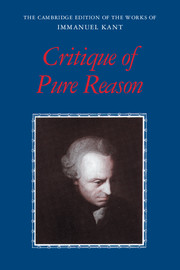Introduction
Summary
Immanuel Kant's Critique of Pure Reason is one of the seminal and monumental works in the history of Western philosophy. Published in May 1781, when its author was already fifty-seven years old, and substantially revised for its second edition six years later, the book was both the culmination of three decades of its author's often very private work and the starting-point for nearly two more decades of his rapidly evolving but now very public philosophical thought. In the more than two centuries since the book was first published, it has been the constant object of scholarly interpretation and a continuous source of inspiration to inventive philosophers. To tell the whole story of the book's influence would be to write the history of philosophy since Kant, and that is beyond our intention here. After a summary of the Critique's structure and argument, this introduction will sketch its genesis and evolution from Kant's earliest metaphysical treatise in 1755 to the publication of the first edition of the Critique in 1781 and its revision for the second edition of 1787.
THE ARGUMENT OF THE CRITIQUE
The strategy of the Critique . In the conclusion to his second critique, the Critique of Practical Reason of 1788, Kant famously wrote, “Two things fill the mind with ever new and increasing admiration and awe the more often and more enduringly reflection is occupied with them: the starry heavens above me and the moral law within me.” This motto could just as well have served for virtually all of Kant's philosophical works, and certainly for the Critique of Pure Reason.
- Type
- Chapter
- Information
- Critique of Pure Reason , pp. 1 - 80Publisher: Cambridge University PressPrint publication year: 1998
- 6
- Cited by

